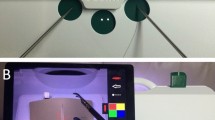Abstract
Background
Telementoring can be an adjunct to surgical training using virtual reality surgical simulation. Telementoring is hypothesized to be as effective as a local mentor for surgical skills training.
Methods
In this study, 20 Romanian medical students trained using a virtual reality surgical simulator (LapSim) with a telementor or local mentor. All the students watched an instructional module at the beginning of the exercise. The telementor, in the United States, interacted by videoconferencing. Before and after training sessions, tool path length and time for task completion were measured.
Results
Instructional media and training with mentoring resulted in similar levels of performance between locally mentored and telementored groups. Right- and left-hand path length and time decreased significantly within each group from the initial to the final evaluation (p < 0.05) for most tasks (grasping, cutting, suturing). No significant difference was achieved for clip-applying.
Conclusions
Integration of instructional media with telementoring can be as effective for the development of surgical skills as local mentoring.









Similar content being viewed by others
References
Gallagher AG, Richie K, McClure N, McGuigan J (2001) Objective psychomotor skills assessment of experienced, junior, and novice laparoscopists with virtual reality. World J Surg 25: 1478–1483
Gallagher AG, Satava RM (2002) Virtual reality as a metric for the assessment of laparoscopic psychomotor skills: learning curves and reliability measures. Surg Endosc 16: 1746–1752
Haluck RS, Marshall RL, Krummel TM, Melkonian MG (2001) Are surgery training programs ready for virtual reality? A survey of program directors in general surgery. J Am Coll Surg 193: 660–665
Hamilton EC, Scott DJ, Fleming JB, Rege RV, Laycock R, Bergen PC, Tesfay ST, Jones DB (2002) Comparison of video trainer and virtual reality training systems on acquisition of laparoscopic skills. Surg Endosc 16: 406–411
Hyltander A, Liljegren E, Rhodin PH, Lonroth H (2002) The transfer of basic skills learned in a laparoscopic simulator to the operating room. Surg Endosc 16: 1324–1328
Institute for Higher Education Policy (2000) Quality on the line: benchmarks for success in Internet-based distance education. The Institute for Higher Education Policy, Washington, DC. Retrieved February 11, 2005 at http://www.ihep.com/Pubs/PDF/Quality.pdf
Kothari SN, Kaplan BJ, DeMaria EJ, Broderick TJ, Merrell RC (2002) Training in laparoscopic suturing skills using a new computer-based virtual reality simulator (MIST-VR) provides results comparable to those with an established pelvic trainer system. J Laparoendosc Adv Surg Tech A 12: 167–173
Pearson AM, Gallagher AG, Rosser JC, Satava RM (2002) Evaluation of structured and quantitative training methods for teaching intracorporeal knot tying. Surg Endosc 16: 130–137
ProMIS Surgical Simulator (Haptica Inc., Boston, MA) Retrieved December 9, 2004 at http://www.haptica.com/id11.htm
Rosser JC, Rosser LE, Savalgi RS (1997) Skill acquisition and assessment for laparoscopic surgery. Arch Surg 132: 200–204
Rosser JC Jr, Rosser LE, Savalgi RS (1998) Objective evaluation of a laparoscopic surgical skill program for residents and senior surgeons. Arch Surg 133: 657–666
Seymour NE, Gallagher AG, Roman SA, O’Brien MK, Bansal VK, Andersen DK, Satava RM (2002) Virtual reality training improves operating room performance: results of a randomized, double-blinded study. Ann Surg 236: 458–463
Simbionix, computerized medical training simulators and clinical devices for MIS. Retrieved December 9, 2004 at http://www. simbionix.com/
Surgical Science. Laparoscopic simulation. Retrieved December 9, 2004 at www.surgical-science.com
Tendick F, Downes M, Goktekin T, Cavusoglu MC, Feygin D, Xu X, Eyal R, Hegarty M, Way LW (2002) A virtual environment testbed for training laparoscopic surgical skills. Presence 9: 236–255
Author information
Authors and Affiliations
Corresponding author
Rights and permissions
About this article
Cite this article
Panait, L., Rafiq, A., Tomulescu, V. et al. Telementoring versus on-site mentoring in virtual reality-based surgical training. Surg Endosc 20, 113–118 (2006). https://doi.org/10.1007/s00464-005-0113-x
Received:
Accepted:
Published:
Issue Date:
DOI: https://doi.org/10.1007/s00464-005-0113-x




